What is the Difference Between Bioguard Smart Shock and Easy Shock and Swim
Summer is coming, and it will be pool season before you know it. But before you dive in, you'll need the best pool shock for your swimming pool. There are lots of different pool shock treatments available and it can be difficult to decide what's right for you. Do you want liquid, powder, or tablets? And which chemicals should you choose?
Shocking your pool is essential for clean, clear water. Shocking involves adding a strong dose of chemicals to the pool water to eliminate contaminants. Even if you're habitual in managing your pool's chemistry, you'll still need to shock your pool from time to time. Most experts recommend doing it weekly.
The most common pool shock treatments are chlorine-based to kill bacteria, but others are chlorine-free and oxidize the water to burn contaminants and many contain algaecide too. They all aim to leave your pool sparkling and safe to swim in.
We looked for the most readily available, best value, and easiest pool shocks to use, whether you have an above-ground pool or an inground pool. We've found that shock in powder form tends to be best for backyard pool owners, so our list focuses on the very best of these.
Whether you're looking for a shock that's budget-friendly, super-strong, or something in between, we've done the research for you and pulled together all our favorites right here.
The best pool shock treatments 2022
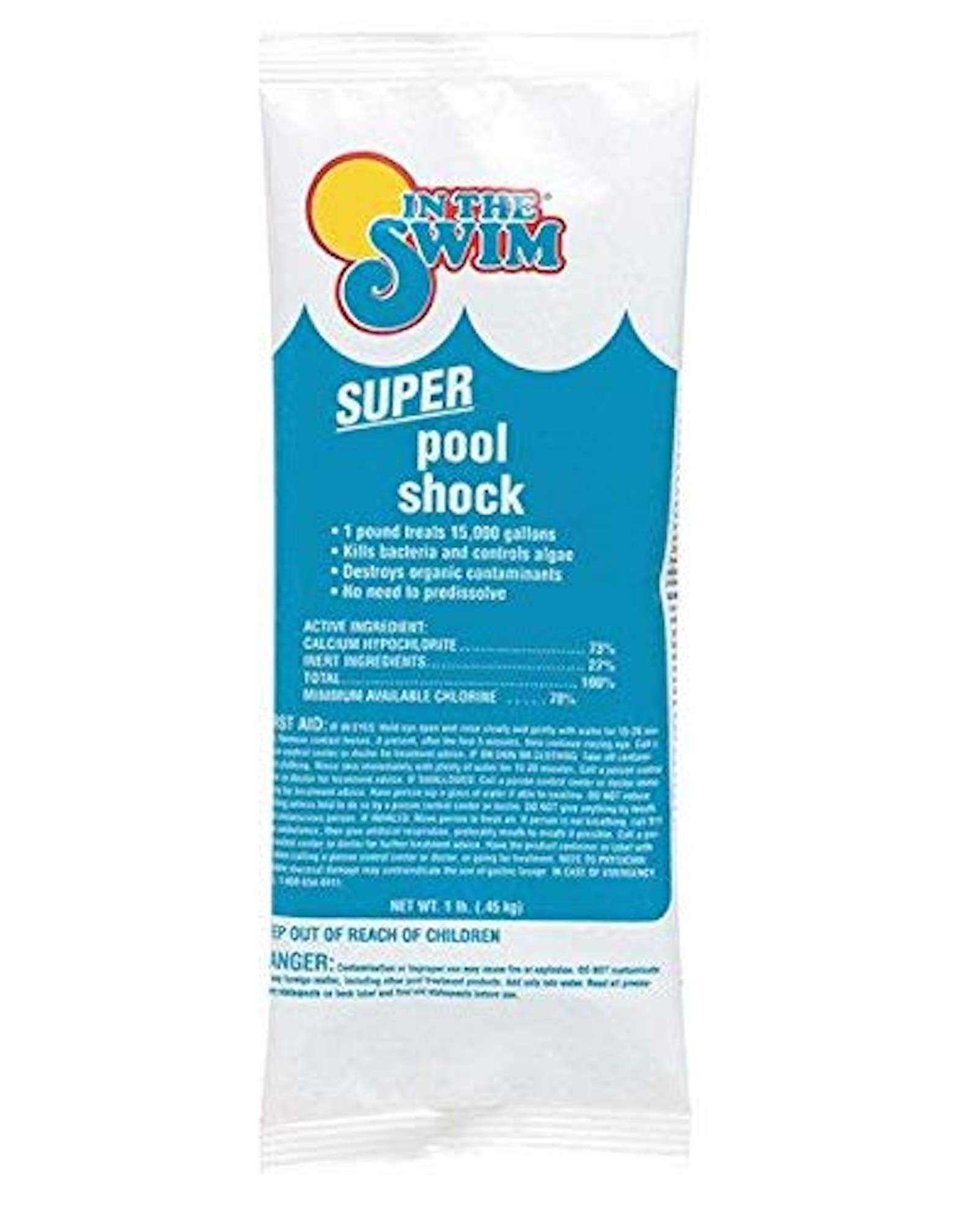
(Image credit: In The Swim)
Taking the top spot, In the Swim Super Pool Shock Treatment is the strongest pool shock on our list with 73% available chlorine. This means it quickly eradicates contaminants like algae and bacteria. It is perfect for getting your pool open for the season and during periods of heavy use and it can even wipe out stubborn algae blooms. Because it's super strong, it's also good value for money as each 1lb bag shocks up to 15,000 gallons of water. Depending on how often you use your pool, you might only need to use it bi-weekly.
We love that they've made it so easy by pre-portioning into small 1lb bags so there's no need to do any measuring at all. This way there's less chance of harsh chemicals coming into contact with your skin. As this is a strong shock, a lot of backyard pool owners will only need to use one bag. You simply pour the bag straight into the deepest part of the pool and leave overnight with the pump running. By the morning you should have crystal clear water that's ready for swimming.
A drawback is that the granules can settle on the bottom of the pool which can bleach the liner or, if you have a vinyl liner, even cause it to become brittle and leak. If you do find granules settle on the bottom of your pool, to avoid damage you can pre-mix shock with water in a bucket and ensure it's completely dissolved before adding it to your pool. This does make the whole process less convenient though.
The active ingredient in this pool shock is calcium hypochlorite. As the name suggests, this does increase calcium levels in your pool. If you have issues with calcium scale buildup due to hard water, this may not be the best choice for you. Perhaps try a trichlor or dichlor option (sodium tri/dichloro-s-triazinetrione) like our next pick below.
Overall, this pool shock is a great buy. In The Swim are a reputable brand in the pool world and this product is very highly rated. It is strong enough to work even if your backyard pool sees heavy use and it is affordable too.
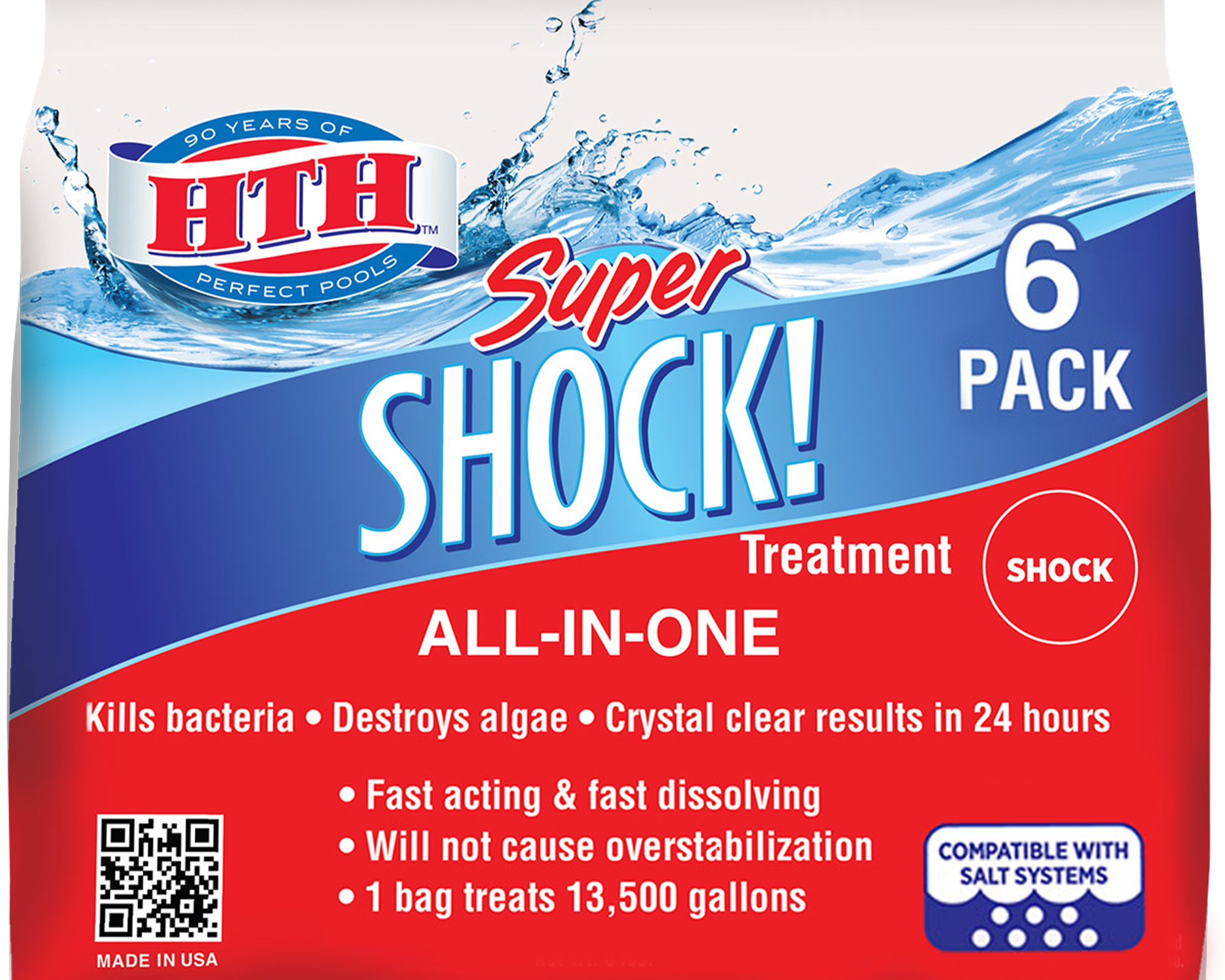
(Image credit: HTH)
This is the quintessential pool shock from the reputable HTH brand. It effectively removes bacteria and other hazardous contaminants to keep pool water clean and it does it at a very budget-friendly price. It's a very close second; it only misses out on the top spot as it is less potent, with only 56% calcium hypochlorite. For regular use though, this shock works great.
It's super easy to use as it's pre-portioned into 1lb bags just like our top choice above, so there's no need to do any measuring. One bag is enough to treat 13,500 gallons. You can pour the bag straight into the deepest part of the pool, leave it overnight with the pump running and you're good to go. To make things even easier, you can round up and use whole bags as the shock won't over-stabilize your pool. No nasty leftover chemicals to dispose of.
The main drawback is that it isn't as strong as some of the other options available so it won't be quite as effective at killing contaminants. Also, we have heard reports that it can sometimes settle on the bottom of the pool and cause stains.
Overall though, this is a great, budget-friendly option that should do well in most pools. It's strong enough to combat bacteria and algae and not too strong for regular use.
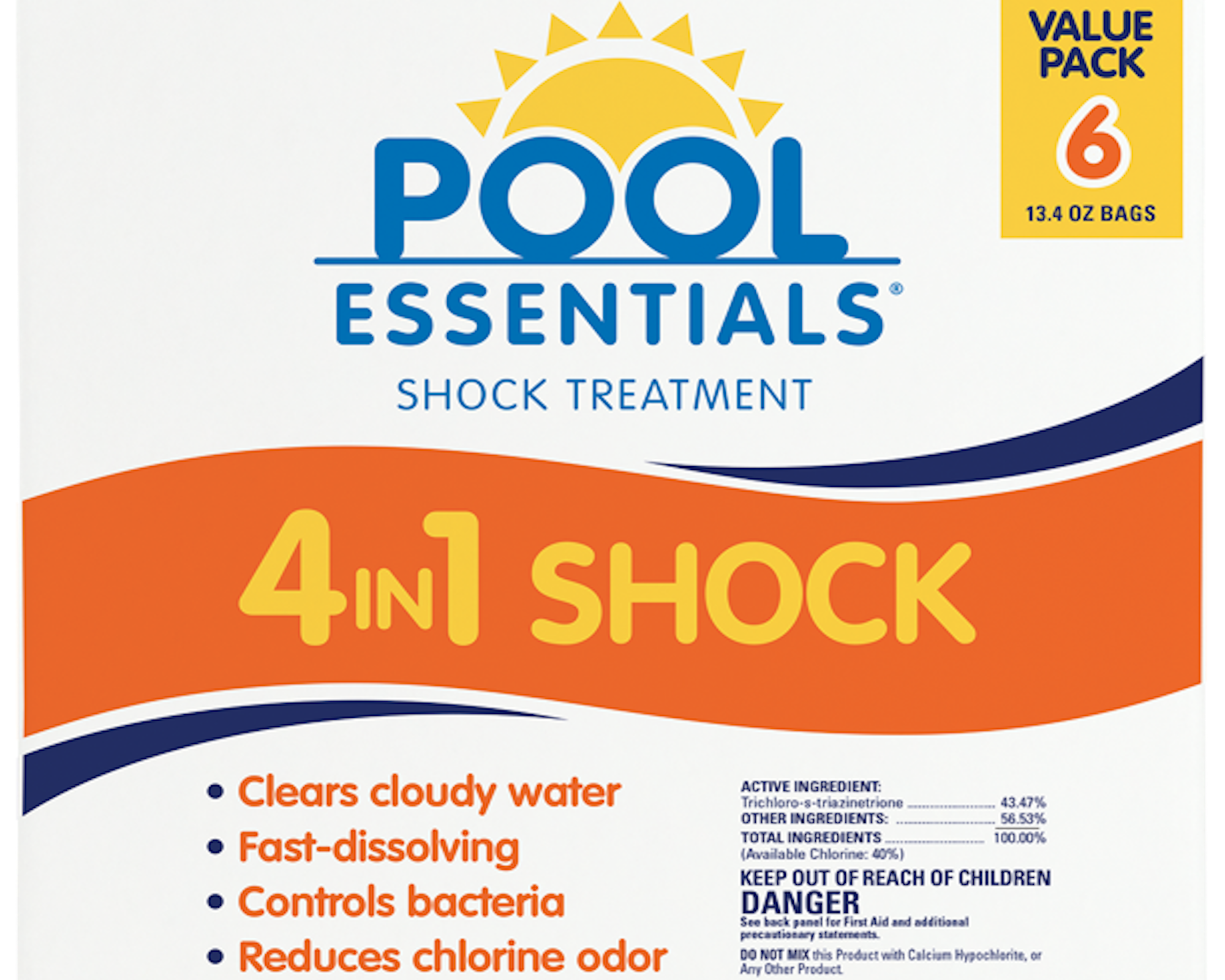
(Image credit: Pool Supply Unlimited)
If you're lucky enough to have a super sunny pool, this trichlor (sodium trichloro-s-triazinetrione) pool shock by Pool Essentials is the one for you. You likely need to add a pool conditioner (aka stabilizer or cyanuric acid) to your sun-soaked pool regularly to prevent the chlorine from evaporating too quickly in all that UV light. This stabilizer essentially acts as a sunscreen for your chlorine. Instead of remembering to add this separately, do it all in one. Use this pool shock about once a week to keep your water clean and clear.
This shock is also fantastic if you have problems with calcium hardness. As the active ingredient is sodium trichloro-s-triazinetrione instead of calcium hypochlorite, it doesn't increase calcium levels in the water and you avoid scaling, prolonging the life of your pool equipment. Using calcium hypochlorite-based shock in a small pool can be especially problematic as the calcium is less diluted and can build up.
This option might work for you if your pool is indoors or shady too, but be sure to test your pool water before you shock. If the cyanuric acid (CYA) level is high, adding this shock with cyanuric acid mixed in is not a good idea. You can throw the PH balance off which can irritate skin and corrode pool equipment. In this case, better to use our top pick above instead.
It is also less strong than our top pick, so it may not be the best option if your pool sees heavy use or has a lot of contaminants. The stabilized chlorine can work for longer though which somewhat counteracts the difference in strengths.
Overall, this is the best pick for a swimming pool that gets a lot of sunshine. It is affordable, easy to use, and super convenient with a pool conditioner built-in.
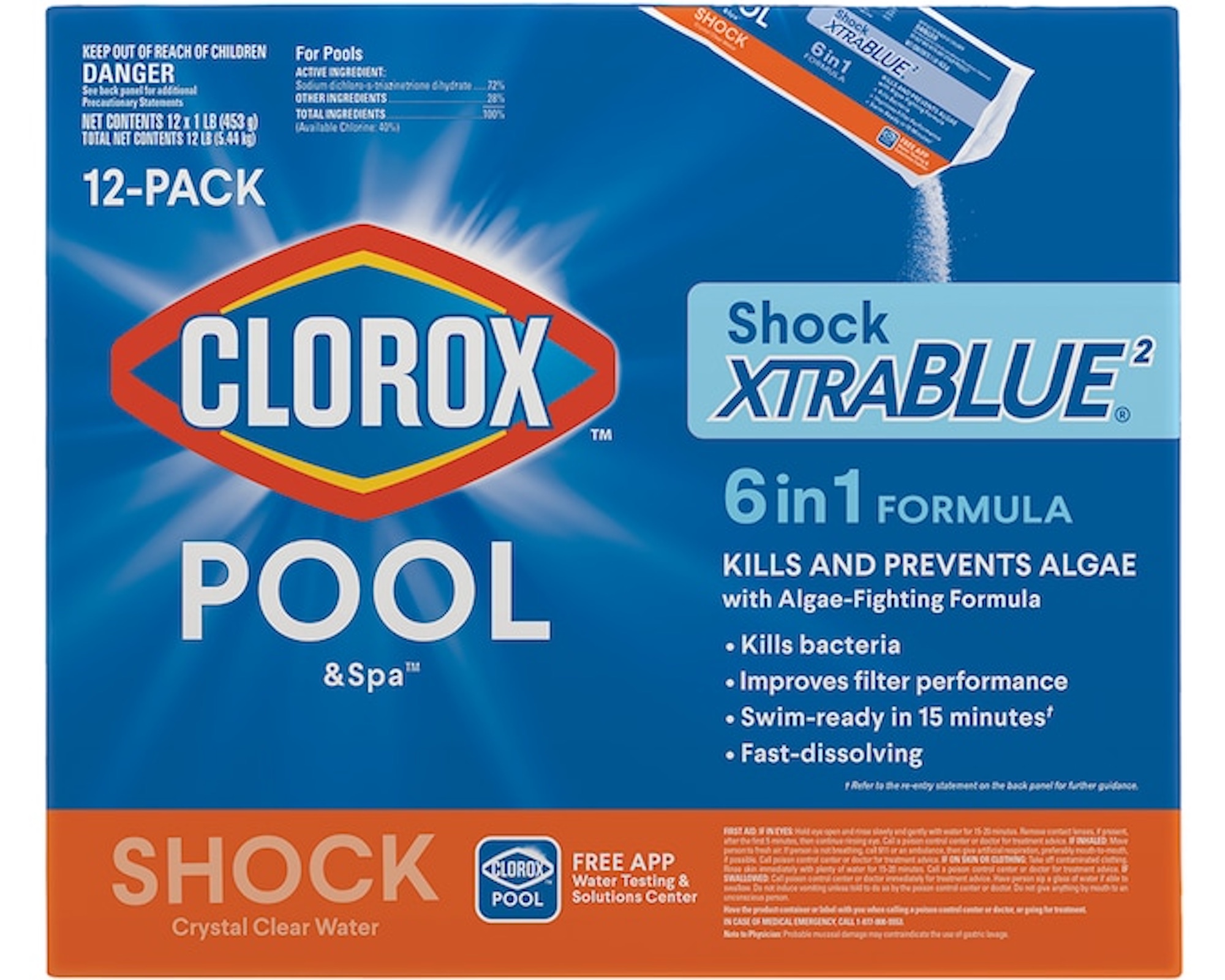
(Image credit: Amazon)
If the sun comes out and you suddenly feel the urge to soak in the pool, the Clorox Pool & Spa Shock Xtra Blue is the shock for you. It can have your pool swim-ready in as little as 15 minutes. The formula is designed to be fast dissolving so it gets to work quickly. Most shocks should be left for around 24 hours, so 15 minutes is incredible. Of course, always test the water before you get in to make sure it's safe.
Usually though, you shock your pool at night for the best results, so the quick-dissolving formula may not seem super important. However, it is super useful when it comes to dissolving granules before they have a chance to settle on the bottom of the pool, which can cause the liner to bleach. This is especially important if you have a vinyl liner, as granules could damage it and cause leaks. You could premix any powder shock or measure out liquid shock, but this is our favorite way to go as it's the easiest option.
Like our second pick above, this shock contains a pool stabilizer so it is also great for use in sunny pools to prevent the UV from eating up the chlorine. It's also great if your pool water has high calcium hardness, as it won't add to the problem as a calcium hypochlorite-based shock would.
We also really like the resealable bottles, rather than the single-use bags that the other pool shocks on our list come in. If you have a smaller above-ground pool, you can use half a bottle and safely keep the rest for next week.
The downside is that it is a little more expensive and a little less potent, so it's not the best value for money. If you use your pool a lot, you may find yourself having to use this shock more often as it has less available chlorine to clear contaminants.
Overall, this is a great option if you have a shallower above-ground pool or any pool with a vinyl liner, as you can apply this fast-dissolving powder directly, without having to worry about granules settling and damaging or bleaching your pool.
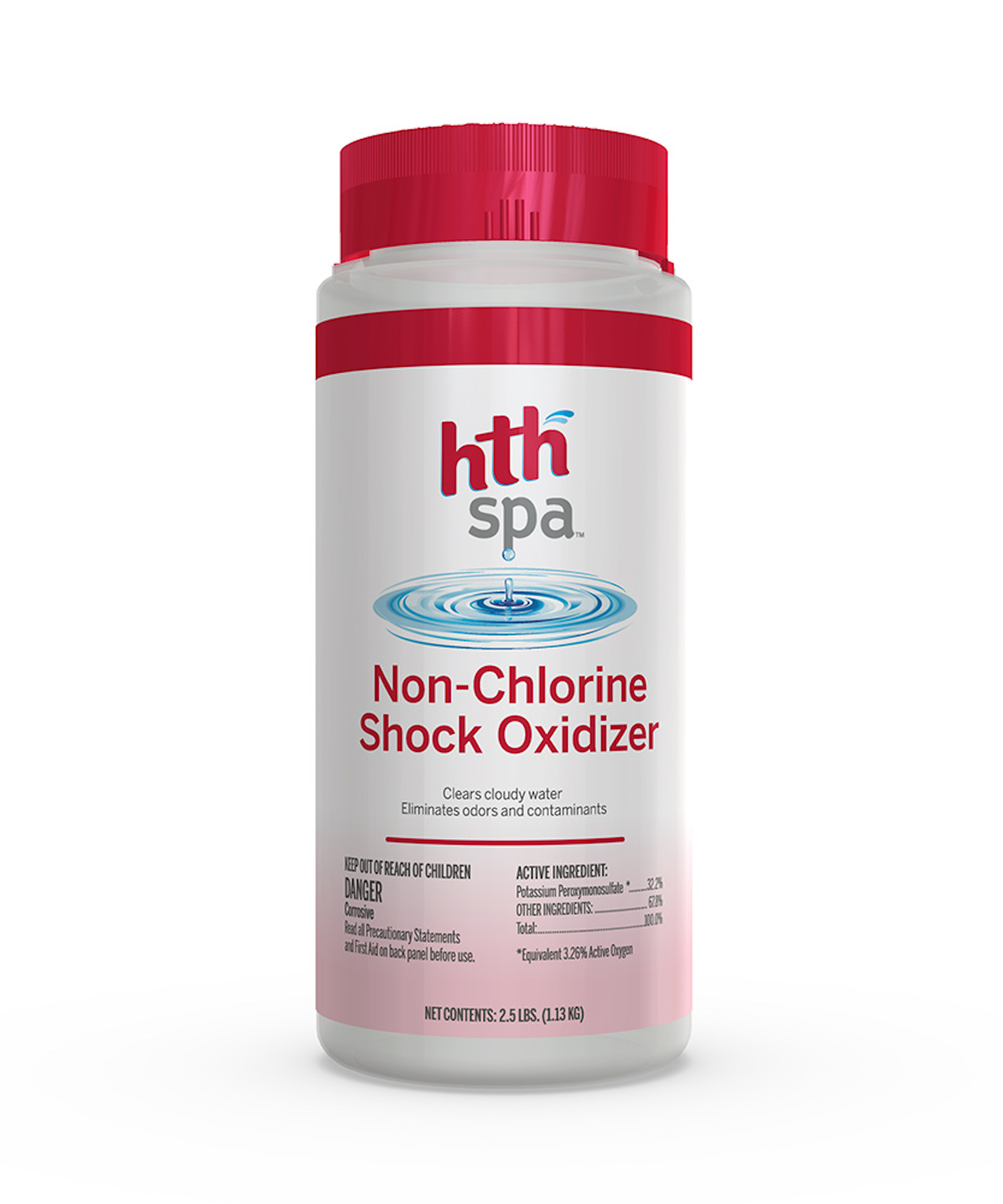
(Image credit: HTH)
The HTH Spa Non-Chlorinating Shock Oxidizer is specifically designed for use in the best hot tubs. Spas are much hotter than pools which can affect the way chemicals in regular pool shocks work. Pool shocks with calcium hypochlorite (cal hypo) as the active ingredient are the most readily available, but these should not be used in hot tubs. At these high temperatures, they would lose their effectiveness very quickly. These shocks also contain calcium which will likely cause scale buildup in a small body of water like a hot tub. Liquid pool shock should also always be avoided in hot tubs, as it raises the chlorine levels too rapidly when added to such a small volume of water.
This non-chlorinating shock is perfect for regular use in your spa. Oxidizing shock treatments burn up organic contaminants which essentially frees up sanitizer so that it can work more effectively. It is gentler than chlorine-based shock so it won't bleach the tub or lid.
It is also very quick; you only have to wait about an hour before entering the tub. If you've had a long day at work and you fancy a quick soak, this shock can be ready by the time the tub reaches temperature. We also love that it's odorless and doesn't irritate the eyes or skin.
However, if you have just had a hot tub party, we would recommend using something a little more potent. Using a pool shock with sodium trichloro-s-triazinetrione or sodium dichloro-s-triazinetrione as the active ingredient is ideal after heavy use. These shocks do contain chlorine but it is stabilized so it fares better in the heat.
Also, if you use too much, HTH Spa Non-Chlorinating Shock Oxidizer can affect the PH levels as the active ingredient, monopersulfate, is acidic. And, if you use too little, you may have issues with algae or bacteria, as oxidizer doesn't sanitize the pool as chlorine does.
If used correctly though, this is all you need to keep your spa water sparkling clean. HTH is a very reputable brand. It is a little more expensive than chlorine-based shocks, but it is gentler on your hot tub equipment, so it's better value in the long run.
There are plenty of tips on how to shock a hot tub in our dedicated guide too.
How to choose the best pool shock
There are lots of different pool shock treatments available, so it's important to find the right one to suit your pool maintenance needs. From the main ingredients it contains to whether it's in powder, liquid or tablet form, here's what you need to consider.
Active ingredients in pool shock
- Calcium Hypochlorite (Cal Hypo) The cheapest and most readily available pool shock is made with calcium hypochlorite. This is strong and efficient, but it can cause calcium buildup or bleach your pool liner.
- Sodium Dichloro-s-triazinetrione (Dichlor) or Sodium Trichloro-s-triazinetrione (Trichlor) Also very popular and effective. It can cause PH imbalance as it contains cyanuric acid (aka stabilizer), but this helps chlorine last longer in UV light so it's great for sunny pools.
- Potassium monopersulfate A slightly less popular, chlorine-free option. Works by oxidizing water to free up chlorine that is already present. It doesn't add calcium or chlorine. It is usually safe to swim again more quickly after applying this type of pool shock.
Powder, liquid, or tablet pool shocks?
There are powder, liquid, and tablet pool shocks available. However, in our buying guide list we focused on powdered pool shocks as these are the most readily available and the easiest to use.
Liquid pool shock needs to be measured out beforehand. These are powerful chemicals and we'd prefer to keep our contact with them to a minimum. It's much easier to just open a packet and pour it straight in.
Tablet pool shock is a little unconventional, as tablets take longer to dissolve and are therefore usually better as a slower release sanitizer, than as a shock. As it takes longer to dissolve, you also have to wait longer until you can swim.
Choosing the right pool shock for your pool type or hot tub
Above Ground Pools
For shallower pools and/or pools with vinyl liners, like above-ground pools, you will want to take extra care to find a pool shock that dissolves quickly. You don't want granules to settle on the bottom of the pool as this can bleach, damage, or even split your pool liner.
Saltwater Pools
Some pool shock products claim to be better for saltwater systems than others, but you can actually use any pool shock in a saltwater pool. As the system is creating chlorine from the salt, shock works the same as in any other pool. Often saltwater systems come with a high setting you can use to produce more chlorine and 'shock' the pool, however, we don't recommend using this regularly, as it can shorten the lifespan of the system.
Hot Tubs
Don't use calcium hypochlorite (cal hypo) shock in a hot tub. The chlorine evaporates too quickly and it can cause calcium buildup in a small volume of water. Don't use liquid shock either, as it increases the chlorine level too rapidly. We would recommend using pool shock (like the one listed above) that is specifically designed for use as part your hot tub ideas, otherwise check with the manufacturer before using.
stclairhowits1990.blogspot.com
Source: https://www.gardeningetc.com/buying-guides/best-pool-shock

0 Response to "What is the Difference Between Bioguard Smart Shock and Easy Shock and Swim"
Post a Comment